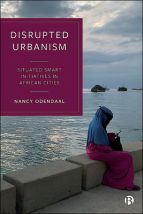Disrupted Urbanism: Situated Smart Initiatives in African Cities

Nancy Odendaal’s book ‘Disruptive Urbanism’ is concerned with the role that digital platforms could play in the future of African cities. In Chapter 1’s opening discussion on the book’s key concepts, Odendaal highlights that dominant narratives on the ‘smart city’ in Africa often lack an engagement with systemic urban issues, generating homogenous visions of future smart cities that fail to attend to the importance of context and are therefore unable to address the urban challenges in Africa. Considering the inadequacy of ‘corporate smart promises’ (p.29), the author explores the potential of platform urbanism to contribute to sustainable and just urban futures.
Chapter 2 locates the book amongst other work on digital platforms and cities, taking note of the inadequate attention paid to local dynamics in much of this literature. Informed by African urbanism and postcolonial science and technology studies (STS), the book uses a situated approach and a focus on ‘everyday’ urban life as a lens through which to study the socio-technical dynamics of bottom-up, disruptive smart initiatives in African cities. These initiatives are disruptive in that they prevent the normal continuation of the city’s processes and disrupt the binary of global and local.
The capacity for disruptive initiatives using digital platforms to contribute to systemic change in cities is of particular interest here. Examples of such initiatives are used to explore the themes of (Chapter 3) mobility; (Chapter 4) food security; (Chapter 5) urban activism; and (Chapter 6) public life and imagination in African cities. These themes represent challenges that could be addressed through smart means and are relevant to the futures of cities across the continent.
Chapter 3 uses the example of SafeBoda, an app developed in Uganda, to explore the impact of digital disruptions on mobility systems. The chapter reinforces the importance of place in understanding how apps travel and ‘land’ in different contexts; this close attention to context is juxtaposed with the ‘placelessness’ (p.66) of mainstream depictions of the smart city. Chapter 4 moves on to examine the theme of food security, an issue that can be used to understand the ties between platform and infrastructure studies as apps become increasingly embedded in urban spaces. The evolution of the CTT initiative in Cape Town from distributing food during the COVID-19 lockdown to community connection and social mobilization is used to highlight how disruptive practices can be used as strategies of resistance in the face of unequal power dynamics and spatial inequalities.
In Chapter 5 Odendaal further considers how these disruptive strategies can contribute to inclusive future cities in relation to livelihoods. The concept of ‘cyborg activism’ is developed through a focus on the relationship between social mobilization and the use of technologies. The use of digital tools to generate knowledge on the city in this hybrid form of activism creates relational spaces for collective sense-making and draws attention to systemic issues. Odendaal finds evidence that disruptive practices that harness technology for activist purposes can contribute to systemic change, but the agency driving this change is shaped by place-based dynamics and constraints.
The concept of cyborg activism is used in Chapter 6 to consider the future of African urban spaces, and Afrofuturism introduced as a lens through which to understand how imaginaries of future urban spaces can be contextually informed and include dynamics of African cities that tend to be written out in mainstream visions of smart cities, such as informality and infrastructural failure. Three place-based examples of smart initiatives in Kenya highlight the ways in which technology can promote alternative imaginaries of future cities and expand definitions of the public and citizenship.
Chapter 7 uses the study’s conceptual approach of postcolonial STS to frame a discussion on the key findings from the preceding thematic chapters. The final chapter reflects on the hybrid nature of the disrupted city revealed within the book’s findings; a demonstrated ‘messiness’ sits in contrast with the technological determinism still pervasive in thinking and policy on smart cities. More nuanced understandings of technology appropriation that recognize the importance of engaging with the dynamics of place are therefore recommended for future research. Odendaal’s work concludes with a cautiously hopeful outlook on the potential for disruptive practices that utilize digital platforms to respond to contextual needs and contribute to more inclusive urban futures.
Book Note prepared by Isis Barei-Guyot.
Search the Book notes database
Our Book notes database contains details and summaries of all the publications included in Book notes since 1993 - with details on how to obtain/download.
Use the search form above, or visit the Book notes landing page for more options and latest content.
For a searchable database for papers in Environment and Urbanization, go to http://eau.sagepub.com/

